Used for generations to store and preserve our food, pie safes are one of the most valuable pieces of antique furniture you can invest in. And they are making a huge comeback to interior design.
They’re versatile pieces of furniture that can easily fit into any modern kitchen, pantry, dining room, or living room with ease. Many are used for their original purpose or transformed into beautiful display cabinets.
What’s more, many interior designers and collectors are interested in their signature scruffy, untouched appearance. They rarely require any restoration to fetch big at auction.
Today, we’re going to explore just what makes antique pie safes truly shine in the eyes of a collector – and more importantly, if your cabinets can fetch a small fortune.
Table of Contents
History of pie safe
Nowadays, pie safes are incredibly popular with interior trends like ‘shabby chic’; the older it looks and the more wear-and-tear on show, the better.
But appearances aside, pie safes had a very important function throughout history. Pie safes most likely originated from German immigrants in the Pennsylvania region in the late 1600s.
Tin the days before refrigeration, pie safes helped keep perishable foods like pies, bread, and jelly safer, fresher, and for longer.
It did so by ventilating the food through tiny holes in the door panels of the cabinet. Hot air could escape slowly, and the baked goods could cool off.
The screen helped to keep pests, bugs, rodents, and even small children from coming in contact with the food. It also prevented moisture build-up, preventing mold or bacteria from growing.
Panels also had a decorative element. Ventilation holes were often strategically to form symbols, like stars, hearts, birds, or flowers.
In the early 1900s, however, the icebox revolutionized food preservation. A survey in 1907 found that 81% of American families owned one. Pie safes soon became obsolete.
Styles of antique pie safe
Although pie safes date back to the 18th century and were made right through until the early 1900s, they didn’t go through that many transformations. They remained simple in design.
After all, families bought them for their storing ability, and not just on their appearances. That said, there are some ways of categorizing slight differences between different models:
Size
Size is the easiest way to categorize pie safes. This usually involves looking at the number of shelves and columns of the safe.
Inexperienced buyers mistake kitchen cabinets or kitchen drawers for pie shelves. You can easily spot the difference by keeping these two size templates in mind:
Three-shelf safe – similar in size to a bureau, this type of pie safe has three upper shelves on top. A set of perforated doors helped maintain a healthy airflow.
Half-sized safe – the same size as a chest of drawers, they only had a set of lower shelves and took up less space.
Wood used
During the 18th and 19th centuries, furniture makers used locally sourced wood for their work. If we check the types of wood available, we can predict where the furniture was likely made, and what style was adopted.
The 4 main wood types include:
- Softwood: found in the North East, including New York, Maine, and West Virginia.
- Yellow pine: found in the East, including North Carolina, South Carolina, and Georgia.
- Spanish cedar: found in the South, including Texas and Louisiana
- Cherry & Curly maple: uncommon in all areas – most likely imported.
Color
Most early pie safes had a natural wood finish with no paint applied.
However, as time moved on, furniture designers became heavily influenced and inspired by the changing times. In the 19th century, designers began to experiment with using paint. Popular colors of the time included blue, green, and yellow.
Doors
The most popular material used to create the doors of the pie shelf was tin.
Tin was easy to work with and long-lasting. Designers could punch holes throughout the panels easily.
Other less common materials included cane and glass. While both worked well, they were often more expensive to work with.
Construction
Pie safes can have slight variations to their construction that make them unique.
Some safes had a hutch-inspired design, where the lower shelves jutted out from the upper part. This ‘hutch’ acted as an additional shelf and was useful for storing or displaying kitchenware.
The other popular variation is the pie safe cabinet. It had no special dimensions and stood rather plainly like a display cabinet. These were often tall and thin and free-standing.
How old is my pie safe?
Generally speaking, two prime periods are the most common in antique pie safes; the early 1800s, and late 1800s.
So how can you tell which period your pie safe is from?
- Square nail heads – examine the nails of your pie safe. Square nail heads date from the late 1700s until 1830 and their presence indicates your pie safe is older than most.
- Headless machine-cut nails – these nails replaced square heads from the 1890s onwards.
- Aging wood – Examine the inside of your pie safe itself, as these surfaces won’t have been painted or varnished. Check the wood type against popular raw materials in the area.
- Paint job – If your safe has a coat of paint, don’t worry. This can still help us date the piece. Remember, furniture only started to be painted from the early 1900s onwards. Original paint should have some visual aging, like peeling.
- Check for the finishings – visible saw marks date furniture before the 1830s before circular saws became the norm.
- Restored? Even if your pie safe has been partially restored, new fittings, screws, and fixtures can alter how we date it. If pre-owned, review its history and check all areas are in the same good condition – or are there signs of specific touch-ups or light repairs?
What is the value of an antique pie safe?
Every listing is unique. Price can depend on several unforeseen factors including what’s in demand and what’s on sale.
However, we’ve taken a sample size of auction information and whittled down what have been the deciding factors on value.
Unrestored Pie Safe
Though it can be tempting to spruce up your pie safe, splash some new color on it and fix that broken hinge – we’d advise you against it if you are planning to resell it at auction.
Wear-and-tear often adds to the appeal of this furniture and sprucing it up with fresh knobs, hinges, and panels can devalue it significantly.
A good example is this 1800s Tin panel Pie Safe. Although it shows obvious signs of wear and tear, it is still worth over $1,500 at auction.
Reasonable Condition
Although minor damage, peeled paint, and signs of wear-and-tear are appealing for pie safes, be reasonable about its overall condition.
At some level, it must meet basic standards for auction. Extreme damage like cracks and chips can reduce its overall appeal and make it less desirable for restoration by collectors.
Knobs and panel doors should be included and open and close properly. If it has a drawer, it should close without fail.
Despite cosmetic damage, this pie safe can still fetch up to $500 at auction because it’s operational and includes all its original fixtures and fittings.
Shipping
Pie safes are some of the largest pieces of antique furniture. And anything that large often costs a small fortune in shipping.
So whilst pie safes can be expensive on their own, shipping can make them even more expensive – or valuable, depending on if you’re a buyer or seller.
It is very common for sellers to stipulate who they can sell to and who they can’t. Some may only sell to people who can collect the cabinet in person.
Increased shipping costs can mean buying pie safes from abroad can prove very costly. Sellers often inflate the price to cover any additional fees they might incur.
Rare models sell for more
Unique models attract more attention and fetch a higher price from collectors and hobbyists alike.
Perhaps the safe has special decorations in the panels, the wood might be carved unusually, or have an attractive grain through it?
The original color might be rare for the time, or the pie safe is in impeccable condition and not restored.
A good example of a unique pie safe is this 1850s cast iron Pie Safe valued at $3,500, which has intricate wood carvings on door panels and two drawers.
Does age matter? Only sometimes
Most antiques increase in value over time. But when pie safes are concerned, it’s not that impactful.
Granted, older, vintage models are valuable because they are in short supply. But throughout our research on auction listings, the date has little impact on how high a pie safe will sell for.
For example, this 18th-century Walnut Pie Safe sells for an impressive $899. However, this polished, modern-looking pie safe was made as recently as the 1950s, and yet sells for a staggering $1,096.
Whilst these evaluations are on a case-by-case basis, it does show that market trends follow other criteria than just the antique’s age.
Q&A
What was the drawer on a pie safe used for?
The pie safe’s drawer often stored silverware, napkins, and plates.
Do pie safes have glass doors?
Although tin was the most common material, glass was also used in the design of pie safes. Its transparency meant people could see the food as it cooled, and it offered more opportunities for design elements, including stained glass.
It’s thought the glass was used more and more in pie safes because it was deemed more attractive by potential consumers during the 1800 and 1900s. But this was the exact time that iceboxes took fold, so glass never had enough time to become mainstream.
How do you restore an old pie safe?
Whether you’re a hobbyist or professional wanting to turn around an old pie safe, restoring these cabinets to their former glory can be fun and easy.
You can also turn a nice profit restoring old furniture into something modern, so long as you know what you’re doing! There is an abundance of YouTube tutorials explaining antique restoration.
For pie safes specifically, you will need to follow schematics. Two sites are very useful for this:
- Woodworkers Workshop has lots of schematics available online with clear instructions.
- Van Dykeshas a selection of vintage hardware, including original screens and plating for sale.
Furniture restoration guidebooks have step-by-step instructions on how to preserve, restore and revive pie safes. Three of our favorites include:
- ‘Rescue, Restore, Redecorate: Amy Howard’s Guide to Refinishing Furniture and Accessories’ by Amy Howard
- ‘The Practical Illustrated Guide to Furniture Repair & Restoration’ by William Cook
- ‘Restore, Rebuild, and Renew Wooden Furniture’ By Brian Hingley
Where can I buy and sell vintage pie safes?
Whether you have an antique pie safe ready and waiting to be sold, or fancy buying a fixer-upper to restore, auction sites are often your best.
There are two prime destinations to buy and sell pie safes. These are:
- eBay– one of the most popular antique auction sites. It has a bustling pie safe community, which sells cheap and rare pie safes. Prices range from between $200 to $2000.
- Etsy– the majority of listings are for restored pieces. Prices are lower than on eBay, ranging from $100 to $1,600.
Stuck on how much you should price your pie safe? WorthPoint is one of the most useful antique price guide websites going. Although it requires a subscription to view listings in full, it may well be worth your time to gain a fuller picture of the pie-safe market.
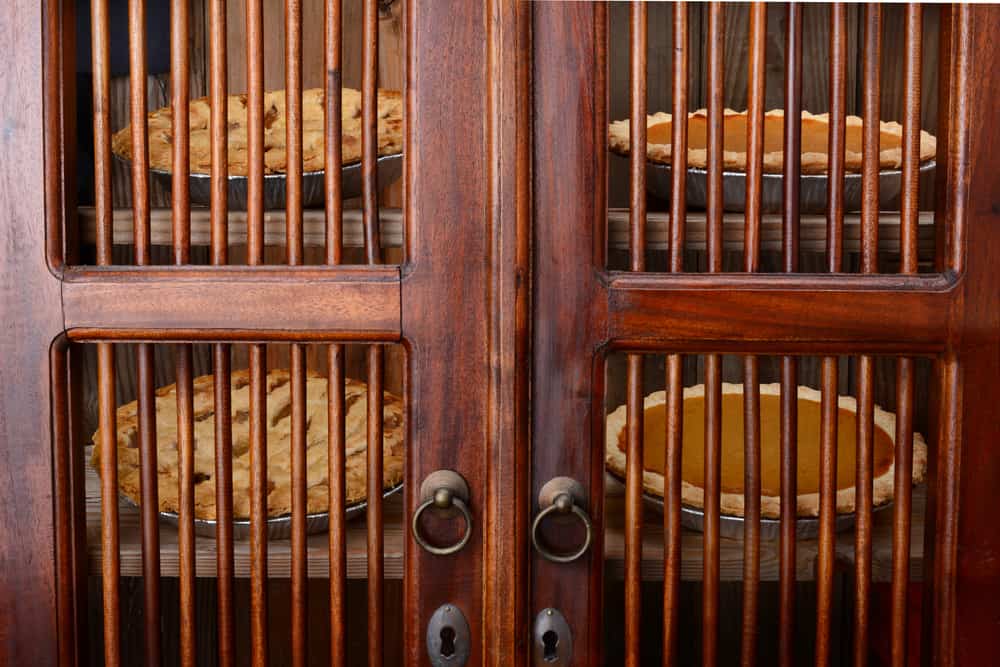
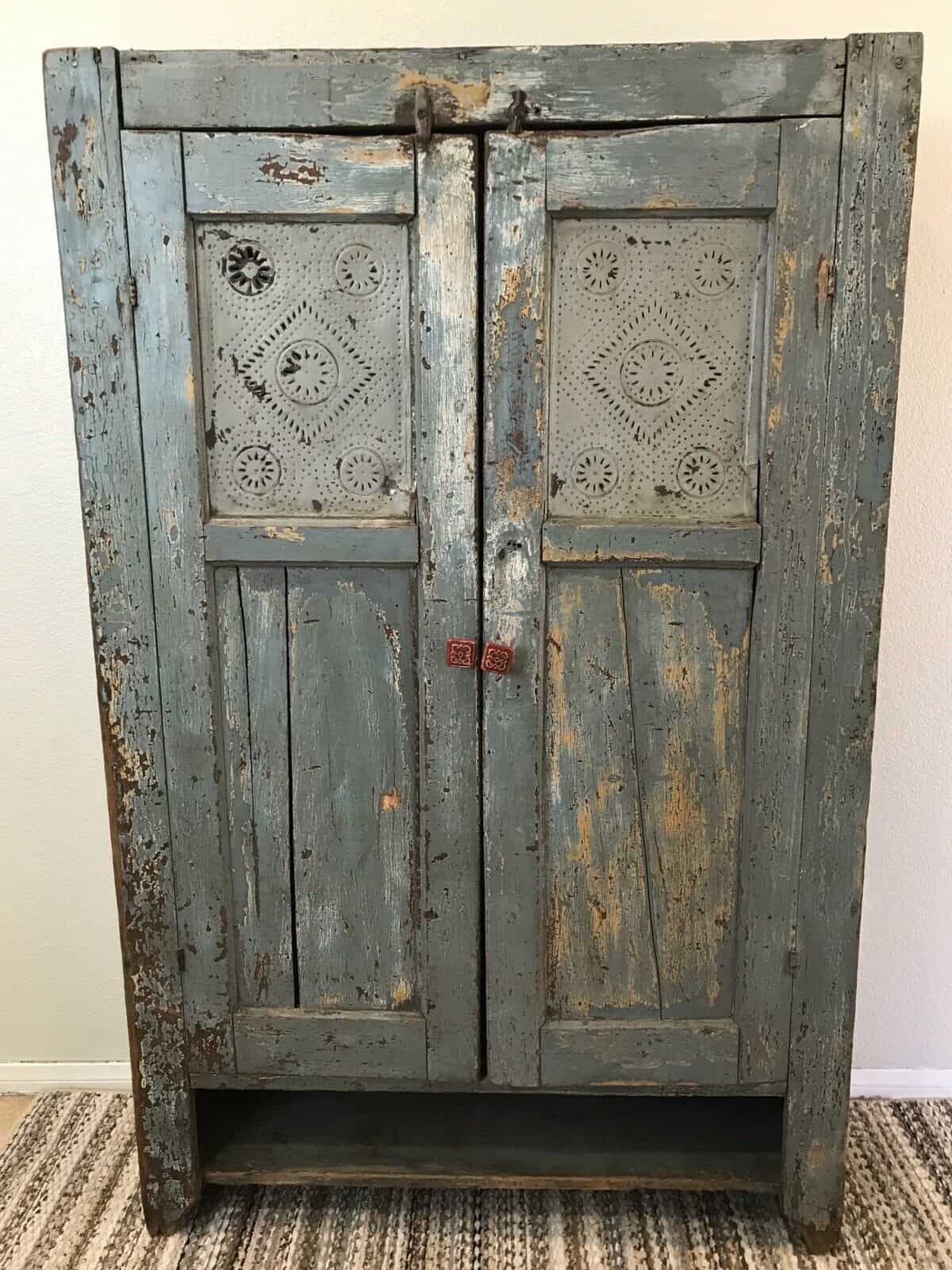
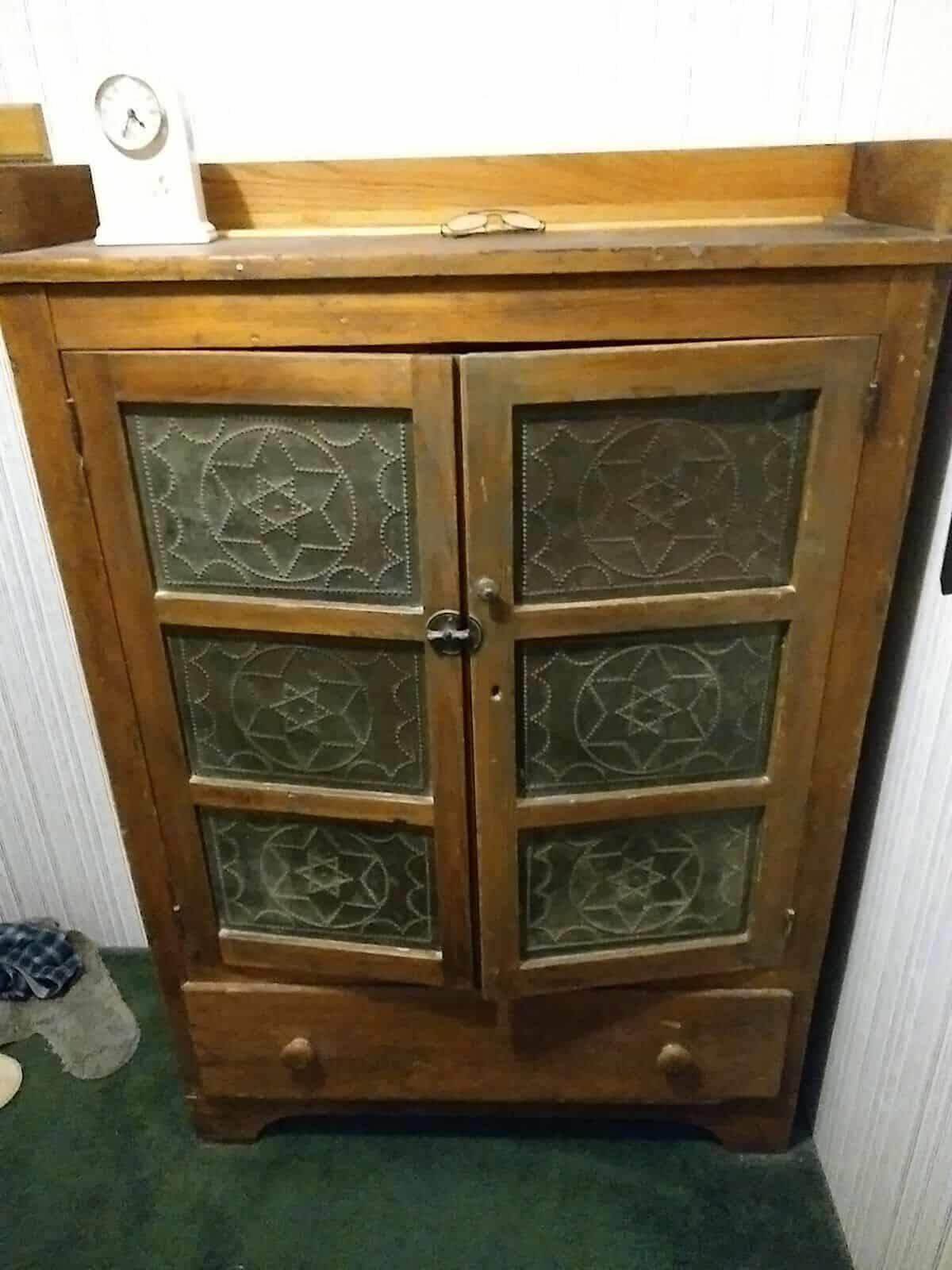
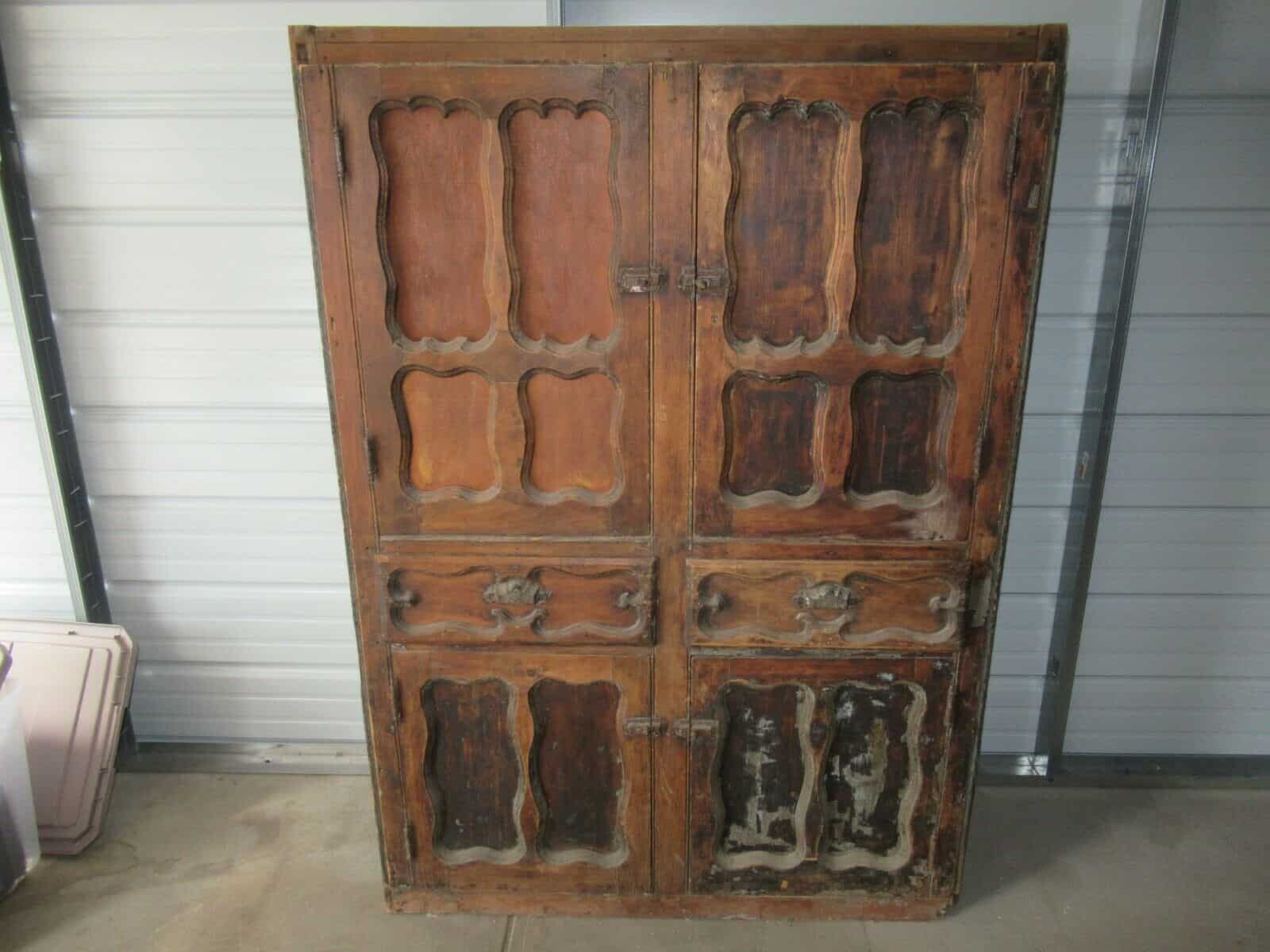
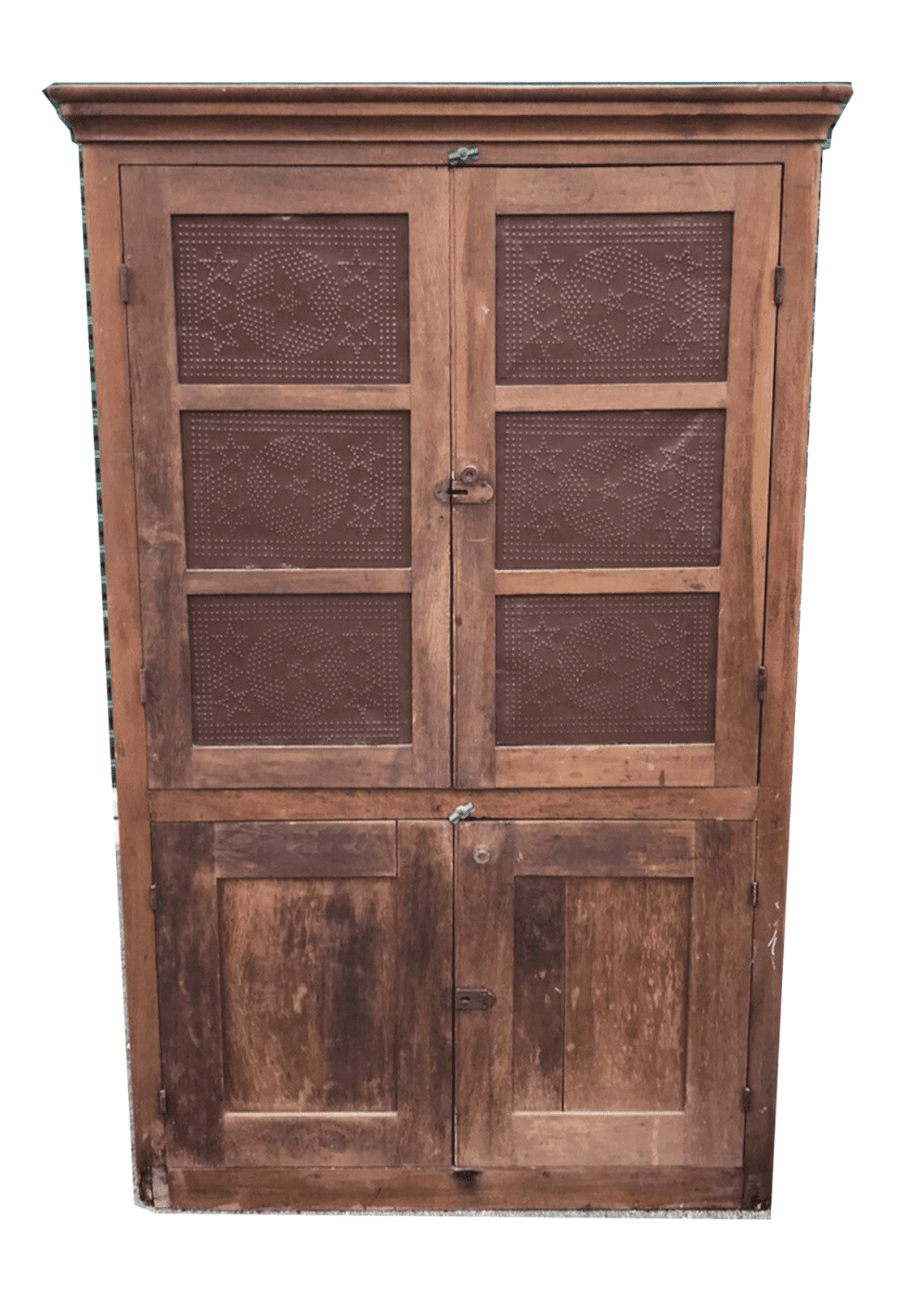
I recently purchased a jell cabinet/pie safe.
What’s unusual about it is that it has no nails. It is fitted together with slatted boards. to make it easy to move?
The upper part has shelves behind two glass doors. The middle has two drawers and the bottom has two wood doors. The lower section also has vent/air holes covered in mesh.
The wood seems to be cedar.
Do you have any idea of the age or possible location it is from?
I have pictures but wasn’t able to attach to this email.